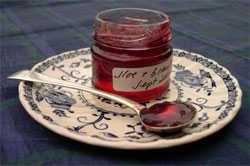Sloe and Bramley Apple Jelly Recipe
Posted by Fiona Nevile in Jam Jelly and Preserves | 110 comments
Tiny pot of sloe and apple jelly
This recipe makes a good raunchy jelly to eat with red meat, game and strong cheese. It’s also great as a sauce base for red meat, such as lamb chops. Danny usually adds a generous dollop to his pheasant casserole and dinky individual game pies, rather than adding a slug of port or sloe gin. As Sloe and Bramley Jelly has a good, strong depth of flavour it is definitely worth making a decent batch for your store cupboard. We use a bit more sugar than the usual 1pt/1lb ratio with this jelly and this seems to work well as we always use cooking apples.
Ingredients:
- 1 1/2 pounds/700g sloes, washed
- 1 1/2 pounds/700g of bramley cooking apples (ideal) or any other cooking apples. We use windfalls as they won’t keep.
- Sugar (1 UK pint/750ml/2 1/2 cups of strained juice to 1 1/2 pounds/700g of white granulated sugar, if using cooking apples. 1 pint/750ml/2 1/2 cups of strained juice to 1 pound/454g if using sweet eating apples).
Method:
- Wash the apples, cut out bad bits and chop roughly. There is no need to peel or core the apples.
Place sloes and apples in a large deep heavy bottomed saucepan, or preserving pan. - Add water to cover ½ of the fruit. Bring slowly to the boil and simmer very gently until all the fruit is soft and squishy. (This can take anything from 20 minutes to an hour, depending on how ripe the fruit is.)
- Pour the cooked fruit through sterilised muslin (how do I sterilise muslin? See tips and tricks below). The muslin is often referred to as a “jelly bag”. We use tall buckets to catch the drips from the jelly bags. Rather than hang the bags (conventional method-between two stools) I find it easier to line a large plastic sieve with the muslin. This clips neatly onto the top of a clean bucket. The sieve is covered with a clean tea cloth to protect against flies.
- Leave the jelly bag to drip overnight (or about 12 hours).
- Measure the juice the next day.
- Pour the juice into a deep heavy bottomed saucepan and add 1½ lb/700g of white granulated sugar for each 1pt/570ml of juice.
Heat the juice and sugar gently stirring from time to time, so as to make sure that that all the sugar has dissolved before bringing the liquid slowly to the boil. - Continue to boil for about 10 minutes before testing for a set. This is called a rolling boil. (What is testing for a set? See tips and tricks below).
- Tossing in a nugget of butter towards the end will reduce the frothing that can occur.
When jelly has reached setting point pour into warm sterilised jars using a funnel and ladle. (How do I sterilise jars? See tips and tricks below). - Cover immediately with plastic lined screw top lids or waxed disks and cellophane tops secured with a rubber band.
- Label when cold and store in a cool, dark place. Away from damp.
Tips and tricks:
- What is a jelly bag?
A jelly bag is traditionally a piece of muslin but it can be cheesecloth, an old thin tea cloth or even a pillowcase. The piece needs to be about 18 inches square. When your fruit is cooked and ready to be put in the jelly bag, lay your cloth over a large bowl. Pour the fruit into the centre of the cloth and tie the four corners together so that they can be slung on a stick to drip over the bowl. Traditionally a stool is turned upside down, the stick is rested on the wood between the legs and the jelly bag hangs over the bowl. We experimented and now line a sieve with muslin, place it over a bucket and cover the lot with clean tea cloths (against the flies). - How do I sterilise muslin/the jelly bag?
Iron the clean jelly bag with a hot iron. This method will also sterilise tea cloths. - Jam “set” or “setting point”?
Getting the right set can be tricky. I have tried using a jam thermometer but find it easier to use the following method.
Before you start to make the jam, put a couple of plates in the fridge so that the warm jam can be drizzled onto a cold plate (when we make jam we often forget to return the plate to the fridge between tests, using two plates means that you have a spare cold plate). Return the plate to the fridge to cool for approx two minutes. It has set when you run your finger through it and leave a crinkly track mark. If after two minutes the cooled jam is too liquid, continue to boil the jam, testing it every few minutes until you have the right set. The jam is far more delicious if it is slightly runny. - How do I sterilise the jars?
We collect jars all year round for our jelly, chutney and jam making sessions. I try to soak off labels and store the clean jars and metal plastic coated screw-top lids in an accessible place. The sterilising method that we use is simple. Just before making the jam, I quickly wash and rinse the jars and place them upside down in a cold oven. Set the temperature to 160c/140c for fan assisted. When the oven has reached the right temperature I turn off the heat. The jars will stay warm for quite a while. I only use plastic lined lids for preserves as the all-metal lids can go rusty. I boil these for five minutes in water to sterilise them. If I use Le Parfait jars, I do the same with the rubber rings.
Leave a reply






Steve B, if it is any consolation my first ever batch of Quince jelly went wrong in a similar fashion too!
It is worth persevering! My tip would be to pop the lid on the pan and simmer it very slowly, I took mine off the heat several times as it carried on cooking with the heat from the pan. This way you shouldn’t loose too much liquid, but if the level does drop considerably add more water and turn the heat down to lessen the evaporation.
Good luck!
Thanks for that, I’ve just re-read the recipe and I was short by about 3 pints! As a word of advice to others, don’t get distracted while heating up the liquid, when it boils over it goes a very long way and takes quite a long time to clean up!
Starting again now.
Hi Steve B
It sounds like you needed more water when simmering the fruit. Try simmering again with more water for another hour or so.
A tea towel should work although muslin is the better option. Don’t discard the fruit pulp before straining. We have a good recipe for quince jelly here http://www.cottagesmallholder.com/?p=102
Hello, I’m trying to make quince jelly, I’ve chopped and simmered the fruit for a couple of hours but when I try to strain it through a jelly bag (or tea-towel) it stops filtering through.
I’ve already discarded the fruit pulp, this is just the liquid. 14 hours later and I’ve got about a tea-cup, it’s as if the juice is too viscous and is clogging the material. Any ideas?
Hi Shelagh,
I haven’t tried using the gin soaked sloes for jelly so I don’t know what it would taste like. Perhaps someone out there does?
I usually use the sloes to make sloe sherry. Our recipe is here http://www.cottagesmallholder.com/?p=104.
It would be worth reading the comments on our sloe gin posts as they are full of ideas for using the sloes. Use the search facility on the site to locate the posts.
Last year I used the sloes from the sloe gin plus a few ‘normal’ ones which I had in the freezer, plus some bramley apples and it made a delicious jelly. Waste not want not is my motto.
I am presently making sloe gin. When I have strained off and bottled the liquid, could I use the leftover sloes for jelly? I had a pound of them, so would add a pound of apples I guess. It seems a waste to throw the gin-infused sloes away. If not jelly, any other suggestions?
Thanks
Hi Annie,
I use rosehips from the garden and hedgerows. I am not aware that there are varieties that are especially good for cooking.
I’ve never used rosehips before either. Can I just use any old ones from the garden or are there specific varieties which are good for cooking?
Hi Harriet,
Rosehips are well worth making into jelly. Our recipe for rosehip jelly is here http://www.cottagesmallholder.com/?p=60
There is no need to prepare them as they are strained through a jelly bag.
If you want to make rosehip syrup, it’s a slightly different story. The rosehips need to be minced. Our rosehip syrup recipe is here http://www.cottagesmallholder.com/?p=121
I’d love to hear how you get on!
I have never used rosehips before – but would love to give it a go. Do I just throw them in whole – or do I need to prepare them in any way first?
Thanks, Harriet